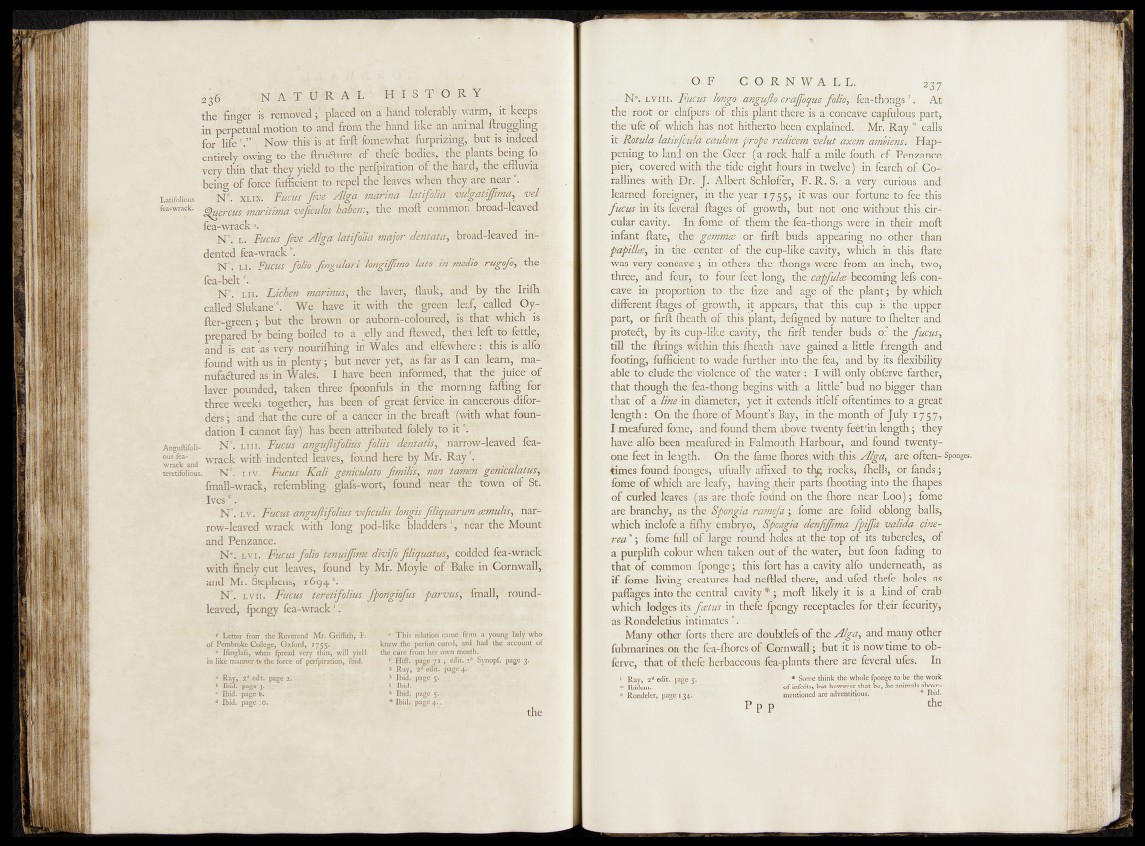
3 23r ?-i-N 'A % I "R'‘A % ; H # | S ^ O - R . J
v th e^ r lg e r
in perpetuafmpWto and from like1 a n t t^ a l ftmfging ,
far life'.” '- ri^ow thi#i:8 at firft'fome^M^furprïziii^, but is»indeed
enürely^owing^to‘tfie ï f ü£tiire’‘of"éHèfë‘bö|fes, plantsjbefag^fafr
very thin that they yield to’thp peifpiratioh ó f thé hand, the effluvia»
being o?fófce fufficiehtïofiëpël the W ^höi thëy;.'atre’^near-z.
Latifoiious bs^ ' '^ t x : l‘ ‘Fucus 'ffoe '"Alga marina ulktifM i>m lgatpm a, vel-
fea-wrack. e ^ rcus 'marttima veficuhs habens,uthé moft coffifnofy broad-lèaved»
fea-wrack v , M " ’ ** , , .
N°. l. Fucusfide Alga latifolia major deiiiaïa, broad-leaved fagj*
dented fea-wrackb. " '
'fsf^ u . Fucus 'folio fmgulari longiffmo lato in medio' rugofo, the
lb%beit\. •
N°. TW. Lachen marinus,the laver, flank, afid by the Irifh,
called; Slukaned. We havfe'' it, with the green | J j j called Oy-
fter-greén; but the brown ór’ aubörn-colöüredsdïs that which' is.»
prepared by being boiled to a jelly and ftewed, thên left fe »fettle,/
and% eatj'^very nouriffling in "Wales apd elfe^h^e r this is alfa\
■ found with us in plenty; but never yet,1 as far as I can learn, mg-
nufa&tred Mfin Wales. I have"been ‘informed;''1 that the -juide pf
laver pounded, taken three fpoonfals in 1 the ‘morning fading for
tfö^ë weeks together, has been o f great fèivice in c^ïtóous difor-
dert* and: that theEture of a cancer in the bfeaft ' (with what foundation!
cannot fay) has béen attributed fcildyWit
Angnfiifoli- 'Fucus anguftifoliics fo liifiW ffia tfsf nlirVow-leaV^^fèa--
Vrafk and wrack with indented leaves, found here % Mr. Ray f.
ttretifolious. N°. i.iv. Fucus Kali geniculato Jimilis, non taihen gèèkülatusy
fmall-wrack, refembling glafs-wort, found dear‘ ^he 'tÖwn of Sti
v e s .'
N°. l v . Fucus anguflifolius veficuMfi<Mjfi/fiiiq^ narrow
leaved wrack with long pod-like bladders1,; near the Mount
and Penzance.
N°. lvi. Fucus folio tenuijfime divifo filiquatuSycodded fea-wrack
with fiiaely cut leaves, found by, Mr. Moyle of Bake in Cornwall,
and Mr. Stephens, 16 9 4 \
N°. L v i i . Fucus teretifolius fpottgiofus 'parvus, finally roundleaved,
fpongy fea-wrack1.
y Letter from the Reverend Mr. Griffith, F.
of Pembroke College, Oxford, 1755-.
* Iftnglafs, when fpread very thin, will yield
in like manner to the force of perforation, ibid.
* Ray, ;.2,d.,edit. page 2. |
S Ibid, page 3.
c IJnd. pia® 6*
4 Ibid, page 10.
’• This relation came frbm a young lady who
knew.the perfon cured, and, had the account of
the atre from her oiyn mouth.
r Hift. page 7 1 ; edit. | | Synopf. page 3.
« Ray, 24 edit, page 4.
1 Ibid, page y.
l Ibid. ' ■ •
k Ibid, page Wm
* Ibid, ; page 4;'.
the
' o y e n ■ c o r m w a l l .
N°. • L’viuiV^k^fMn^bilMg^cii erMjbqfoltfifSMo'i dfea4thongs1. At?
the r0ot»'©r XGilMi^rsr offJthis 'plant, theisms a>* concave eapfulous part,
the'trie of whi'Gtefia’S“>n0,t Mitbertiibeen explained.’;,. Mr. Ray m cglla
itcKotulddmiifm^icUulem. prdjp&ailiiem velut axem dritbienss Happening
to land'on .the'Geer (pjj§£®t:k,half a’.mile foutk'bf, Penzance
pier,' covered with^fe tide eighpfiodrs. iu’'-kwe|ye.V,in fearck'.ofv.Cbd
rallines with' E)r. J; Gilbert: Scfflbffir, E. J^i|^i?'vd^4"duirious and
learned foreigner,l in,the?yearri.^|gSit was 1 ourejfortdnefto fee this
fucus in its feveiklBftages of igr^vtH, buir not’ one without this eir-
cular cavity.’ In fame >'of th&tithe, fea^tHoEg®, were, 1 in’ their moft
infant ftate, :or. .firftlbudsMappe&^ingSrio other-than
papille, in the ^eentert. of iheicup-like cavitywhich -in.rtfris' ftafc;
was very concave ; in„othHfis:,the. thbn'gs,rwerekfiom _ ap inch, two,!
three; and foir^fitd foi^rfebtkloij^rSi^tfe^fifes becoming fefs,con,-,
cave in proportion tbi^ the 'fizef‘ andl^^EScb»; ihe plknt ;iyby. which
different Rages tof/growth, ,it appears,1 that vthisi cup us the upipes,,,
part, or firft fhearff of I this p]ant^ii1|siSgn:ed‘ 'byfjnatuiie t.cs fflelter :and-'‘" '
protedt, by its cup-like cayiiy, the firft tender finds M ffa ^ fu cu ^ \
till the fixings within this fheath have .gained, a litiilb* ftsength and
footing, fafficient td jvade further into' thus fea;kand By»‘i|s
able to elude the! violence of the water : E Wilk.only. o,bfei;ve' farther,
that though the fea-thong begins with a little*' bud no. bigger ,than
that of a line in diameter, yet it extends \itfelf' o^teqtime&|f of a great
length : Ore the fhore of Mount’s Bay^lin thej month ofi|[,uly''i'y5 7 ,
I meafured feme, and found them a,boye- twenty feetjin length ; they
have alfo been meafured- in Falmouth Harbour, and found twenty- ,,
one feet in length. On the fame.fhores. withfthlsi are; Sponges,
limes found fponges, - ufually affixed to th^ rocks, .fhclh,*1 or lands-;
fbme.of which areilda^, havmgitheir parts;ffibbting into the lEapes1*
of curled leaves’ .(as are thofe found on. the* fhore -near Loo)3 fcjmd
are branchy, as the Spongia ramofa ; feme are fblid .»oblong balls,
which inclofe a fifhy embryo, Spongia denfifjima ffiifav^ulida G'ine-
rea ’ ; fbme full of large round’holesi at the tdp of i# ’tubercles,- of
a purplifh colour >when. taken out of the water, but;ioo.n fading to
that of Common fponge; this fort has a cavity alfb underneath, as
i f fame living creatures had neftled there,.' and ; ufed thefe holes as
paffages into the central cavity * ; moft likely itfis a kindofi cr^h-»
which lodges its foetus in thefe fpongy receptacles for their fecurity,,
as Rondeletius intimates0. . %
M a n y other forts there are doubtlefs of the Alga^ and many other1
fubmarines on the fea-fhores o f‘Cornwall; but it is now time to ob-
ferve, that of 'thefe herbaceous fea-plants tShere are/feverd ufes: ■ In
1 Ray, a* edit, page 5, . * Some drink the whole fpongs to be the work
“ Ibidem. 1 infe&; bob1 however that be^ ihe animals abbve-
» Rondelet, page 134.- :. G , ■ '^'»mentioned ar&advehtitioua.' ■ '• Ibid.
P p p the -